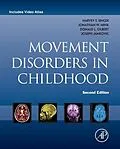Movement Disorders in Childhood, Second Edition, provides the most up-to-date information on the diseases and disorders that affect motor control, an important area of specialization within child neurology. Over the past several decades, advances in genetics, neuroimaging, neurophysiology, and other areas of neuroscience have provided new understanding of the underlying etiologies and mechanisms of these conditions as well as new opportunities for more accurate diagnosis and effective treatment. This new edition builds upon the success of the first edition, with comprehensive scientific and clinical updates of all chapters. In addition, there are new chapters on hereditary spastic paraplegia, quantitative motor assessments, autoimmune disorders, and movement disorders in the developmental neuropsychiatric disorders ADHD, OCD, and autism. Additional materials are provided on the latest in drug treatments, computer based strategies for genetic diagnosis, and helpful videos for phenomenology. - Provides the only current reference specifically focused on childhood movement disorders - Investigates the underlying etiologies and mechanisms of these disorders - Completely revised and updated with new materials and a more disease-oriented approach - New coverage of genetics and movement disorders, immunology and movement disorders, and an introduction to the latest quantitative analysis - New videos of instructive and unusual childhood movement disorders - 2016 BMA Medical Book Awards Highly Commended in Neurology
Autorentext
Harvey S. Singer MD is currently Professor Emeritus at the Johns Hopkins University School of Medicine and active faculty member at the Kennedy Krieger Institute. He grew up in the Bronx and Long Island, went to college and medical school in Ohio (Oberlin College and Western Reserve Univ.), did his pediatric training in Chicago and Cleveland, and his pediatric neurology residency at the Johns Hopkins Hospital. After completing his training, Dr Singer remained on the active faculty at Hopkins for 45 years. He was Director of Pediatric Neurology from 1991 - 2011. He was the first recipient (2013) of the Child Neurology Society's Blue Bird Circle Training Program Director Award and a Hower Award lecturer (2016). His clinical research interests include movement disorders, especially Tourette syndrome, stereotypic movements, and proposed autoimmune disorders. His translational research-oriented laboratory focuses on the neurobiology of stereotypic movements and tics. He has been the recipient of federal and private grants, authored numerous original articles, chapters, and three books. He enjoys biking, travel, visiting his five grandchildren, and work.
Klappentext
Movement Disorders in Childhood, Second Edition, provides the most up-to-date information on the diseases and disorders that affect motor control, an important area of specialization within child neurology.
Over the past several decades, advances in genetics, neuroimaging, neurophysiology, and other areas of neuroscience have provided new understanding of the underlying etiologies and mechanisms of these conditions as well as new opportunities for more accurate diagnosis and effective treatment.
This new edition builds upon the success of the first edition, with comprehensive scientific and clinical updates of all chapters. In addition, there are new chapters on hereditary spastic paraplegia, quantitative motor assessments, autoimmune disorders, and movement disorders in the developmental neuropsychiatric disorders ADHD, OCD, and autism.
Additional materials are provided on the latest in drug treatments, computer based strategies for genetic diagnosis, and helpful videos for phenomenology.
- Provides the only current reference specifically focused on childhood movement disorders
- Investigates the underlying etiologies and mechanisms of these disorders
- Completely revised and updated with new materials and a more disease-oriented approach
- New coverage of genetics and movement disorders, immunology and movement disorders, and an introduction to the latest quantitative analysis
- New videos of instructive and unusual childhood movement disorders
- 2016 BMA Medical Book Awards Highly Commended in Neurology
Inhalt
Section 1 Overview 1. Basal Ganglia Anatomy, Biochemistry, and Physiology 2. Cerebellar Anatomy, Biochemistry, Physiology, and Plasticity 3. Classification of Movement Disorders 4. Diagnostic Evaluation of Children with Movement Disorders 5. Motor Assessments Section 2 Developmental Movement Disorders 6. Transient and Developmental Movement Disorders in Children Section 3 Paroxysmal Movement Disorders 7. Tics and Tourette Syndrome 8. Motor Stereotypies 9. Paroxysmal Dyskinesias Section 4 Hyperkinetic and Hypokinetic Movement Disorders 10. Chorea, Athetosis, and Ballism 11. Dystonia 12. Myoclonus 13. Tremor 14. Ataxia 15. Parkinsonism 16. Hereditary Spastic Paraplegia Section 5 Selected Secondary Movement Disorders 17. Inherited Metabolic Disorders Associated with Movement Disorders 18. Movement Disorders in Autoimmune Diseases 19. Movements that Occur in Sleep 20. Cerebral Palsy 21. Movement Disorders and Neuropsychiatric Conditions 22. Drug-Induced Movement Disorders in Children 23. Functional Movement Disorders Appendices Appendix A: Drug Appendix Appendix B: Search Strategy for Genetic Movement Disorders Appendix C: Video Atlas
